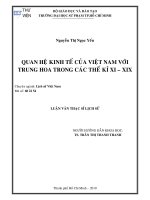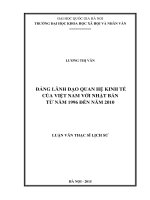Quản trị kinh doanh luôn là một trong những ngành hấp dẫn các bạn trẻ năng động, đặc biệt trong xu thế hội nhập kinh tế Quốc tế của Việt Nam những năm gần đây. Việc tìm hiểu rõ về ngành Quản trị kinh doanh giúp bạn định hướng nghề nghiệp tốt hơn trước kh
Bạn đang xem bản rút gọn của tài liệu. Xem và tải ngay bản đầy đủ của tài liệu tại đây (788.39 KB, 12 trang )
Chapter 8
Motivation and Empowerment
1
Chapter Objectives
Recognize and apply the difference between
intrinsic and extrinsic rewards.
Motivate others by meeting their higher-level
needs.
Apply needs-based theory of motivation.
Implement individual and systemwide rewards.
Avoid the disadvantages of “carrot-and-stick”
motivation.
Implement empowerment by providing the five
elements of information, knowledge, discretion,
meaning, and rewards.
2
Motivation
The forces either internal or external
to a person that arouse enthusiasm
and persistence to pursue a certain
course of action
3
Ex. 8.1 A Simple Model of
Motivation
Need Creates desire to
fulfill needs (money,
friendship, recognition,
achievement
Behavior Results
in actions to fulfill
needs
Rewards Satisfy
needs: intrinsic or
extrinsic rewards
Feedback Reward informs person whether behavior was appropriate and should
be used again
4
Types of Rewards
Intrinsic Rewards
Internal satisfactions a person receives in the
process of performing a particular action
Extrinsic Rewards
Rewards given by another person, typically a
supervisor, such as pay increases and
promotions
Systemwide Rewards
Rewards that apply the same to all people
within an organization or within a specific
category or department
5
Ex. 8.2 Examples of Intrinsic and
Extrinsic Rewards
Individual
Systemwide
Extrinsic
Intrinsic
Large merit increase
Feeling of selffulfillment
Insurance benefits
Pride in being part of
a “winning”
organization
6
Ex. 8.3 Needs of People and
Motivation Methods
Needs of people
Conventional
management
Leadership
Lower needs
Higher needs
Carrot and stick
(Extrinsic)
Empowerment
(Intrinsic)
Control people
Growth and
fulfillment
Adequate effort
Best effort
7
Ex. 8.4 Maslow’s Hierarchy of
Needs
Need Hierarchy
Self-actualization Needs
Fulfillment on the Job
Opportunities for advancement, autonomy,
growth, creativity
Esteem Needs
Recognition, approval, high status, increased
responsibilities
Belongingness Needs
Work groups, clients, coworkers, supervisors
Safety Needs
Physiological Needs
Safe work, fringe benefits, job security
Heat, air, base salary
8
Ex. 8.5 Herzberg’s Two-Factor
Theory
Highly Satisfied
Area of
Satisfaction
Motivators
Achievement
Recognition
Responsibility
Work itself
Personal growth
Motivators
influence level
of satisfaction
Neither Satisfied
nor Dissatisfied
Area of
Dissatisfaction
Hygiene
Factors
Work conditions
Pay/security
Co. policies
Supervisors
Hygiene factors
influence level of
dissatisfaction
Interpersonal. relationships
Highly Dissatisfied
9
Acquired Needs Theory
McClelland’s theory that proposes that
certain types of needs are acquired during
an individual’s lifetime
Three needs most frequently studied:
Need for achievement
Need for affiliation
Need for power
10
Ex. 8.6 Key Elements of
Expectancy Theory
E > P expectancy
Effort
Performance
P > O expectancy
Performance
Outcomes
Valence – value of outcomes
(pay, recognition, other
rewards)
Motivation
Will putting effort into the task lead
to the desired performance?
Will high performance lead to the
desired outcomes?
Are the available outcomes
highly valued?
11
Equity Theory
A theory that proposes that
people are motivated to seek
social equity in the rewards they
expect for performance
12









